Back in 2019, when the world wasn’t so erratic, a viral video caught the eyes of the public. It showed a Lamborghini that, out of all of its peculiarities, could change colors and patterns at the push of a button. But wait, isn’t that impossible? How can a car change the color on the fly? And what’s the reality behind the video?
Color-changing paints, in fact do exist, in two forms: chameleon and paramagnetic paints. Chameleon paints work on the principle of iridescence. They usually use ceramic or mica to achieve the chameleon effect. Paramagnetic paints, on the other hand, use a more active approach. They light up when a current passes through them and can change colors on command.
It turns out, there are certain paints that can change colors. And believe it or not, after paying a hefty premium, you too can implement such a technology on your passenger car.
So is color changing paint real? And how does it work? Take a look at our full guide on color changing paint.

Color Changing Car Paint: Is It Real?

Before we begin debunking the viral Lamborghini video, first let us discuss whether color changing car paints are possible or not. If I had told you that such a car existed back in the ’80s or the ’90s, you wouldn’t have believed me. But recent advances in optical sciences and integrated electronics has made anything possible.
Color changing car paints do exist, but they haven’t come to the spotlight for a number of reasons. One of them could be that, around the time such paints started emerging, most consumers returned to monochrome. This could partly have to do with Apple’s emergence as a world-class luxury brand. And partly due to the advent of the modern era, where minimalism started catching on.
So how does it work? Well, color-changing car paints exist in two forms: iridescent and electroluminescent paints.
Here’s the video of color changing Lamborghini with key:
Chameleon Paint:
Iridescent or chameleon paints do not actively achieve a color change. Instead, they rely on the natural phenomenon of iridescence to create the perception of switching colors. The chameleon paint colors appear to change with the angle of viewing and angle of illumination. But the color effects are more subtle and less customizable.
Electroluminescent Paint:
Electroluminescence, on the other hand, is a fairly recent development, first appearing in the 1960s. The 1960 Chrysler and the Imperial passenger vehicles were the first in the automotive industry to flaunt it. And many subsequent generations of Chrysler cars continue to employ this concept.
This type of paint lights up when an electrical voltage is applied across it. And the best part is that you can customize it however you like, and many achieve a color change depending on the voltage applied. This allows for a variable color shift, close to that of chameleon paint, but with the color pallet of your choice.
Iridescent, Pearlescent, Or Chameleon Paints:
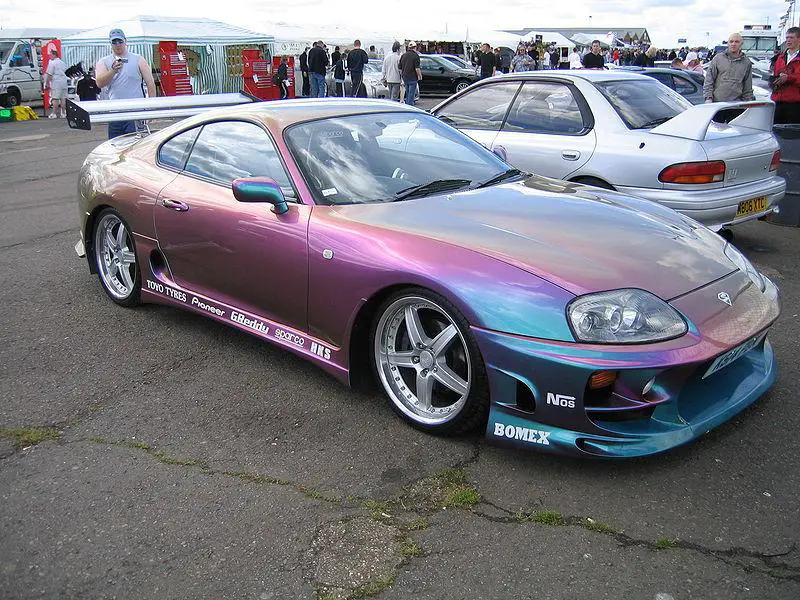
Iridescent paint goes by many names, two of the most common being pearlescent and chameleon paint. They have a technologically advanced composition, which usually varies among different brands.
One of the most well-known brands is the ChromaFlair paint, the official paint used by Porsche’s Exclusiv Manufaktur Program. Through this program, they allow new car owners to fully customize their vehicles. And this includes entertaining requests for pearlescent paint.
ChromaFlair’s pearl pigment paint works by the use of light interference pigments. Colors that are observed by the viewer are the product of thousands of controlled reflections and refractions.
If you want to get an idea of what chameleon paints look like, here’s a video showing such a paint job:
How Much Does A Chameleon Paint Job Cost?
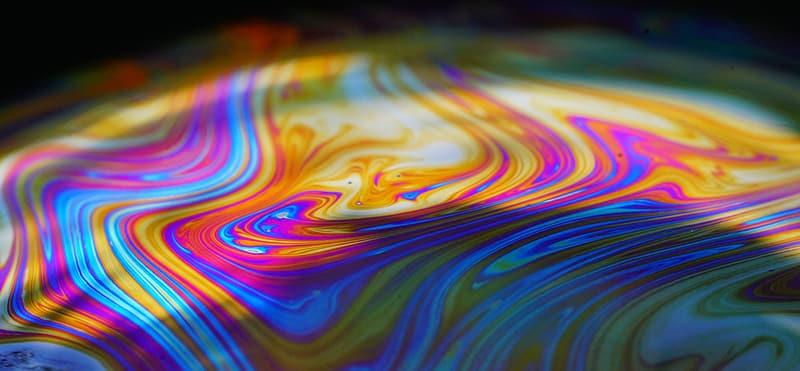
Chameleon paints look stunning when implemented properly. But just how expensive can one paint job get? Judging by the intricate nature of the pigment, it shouldn’t be hard to guess that the numbers go well into the triple digits.
However, you can do your own chameleon paint job if you can buy a few spray cans. But most paints don’t come in the form of sprays, and you’ll have to buy your own aerosol disperser for that. Plus, most pearlescent paints don’t have much of a gloss of their own. This means you’ll have to apply a coat of wax or gloss for the same effect.
At the bare minimum, a chameleon paint job can cost around $3,000. However, if you want good quality, be prepared to spend well over $5,000 to $10,000 on the paint. If you opt to get your car customized as you buy it, then the price can go well into the six digits. Such is the case of the Porsche Exclusive Manufaktur Program, which can cost $97,000.
Electroluminescent Paint: The Next Generation Of Paint Jobs
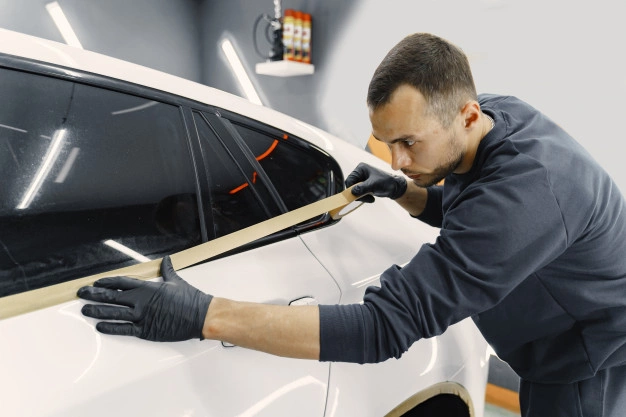
Electroluminescent paint is the real deal. It’s the next generation of paints. The name may sound intimidating, but these paints work on a very basic concept of capacitance. Such paints will light up when an electric current is applied across them and can be visually changed on the fly, if you please.
The way they work is that they consist of several layers, which ultimately form one massive capacitor. This capacitor will emit light when a certain amount of electric potential is passed through it.
Often referred to as paramagnetic paint, it’s available in a few different options:
Electroluminescent Paint:

This is the standard paramagnetic paint. It consists of two layers of power remittance, followed by a dielectric layer, a pigment layer, and a gloss layer. This type of paint will light up a certain color when a current is passed through it.
Such paints are becoming increasingly popular for both their appeal as well as their resale value. A car that’s been customized with electroluminescent paint will sell for higher than that with regular paint.
However, it should be noted that you will have a harder time trying to find someone who wants to buy it. Some people may not like the design. And a lot wouldn’t be able to afford it.
Variable side Color Paint:

Standard electroluminescent paint stays one color throughout its lifetime. However, variable color paint does not. As the name suggests, the color may vary between a range of closely related colors, depending on the voltage applied.
Car enthusiasts who opt for color varying paint get a button installed on their car that changes the color on a whim. Such paints mimic the look of chameleon paints whereby one color seems to graduate into the other. However, unlike chameleon paint, these paints can be controlled by the driver.
Liquid Crystal Paint:
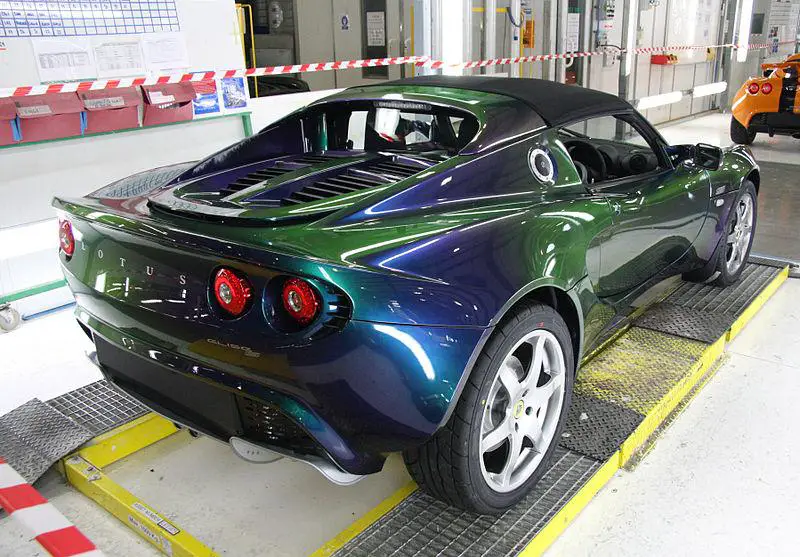
Finally, we have liquid crystal paint, one of the rarer types of paramagnetic paint. This type of paint is based on the concept of the liquid crystal and is the most innovative out of all types of paint.
The gist is that liquid crystal paint varies color based on the temperature on its surface. The colors approach red at 27 degrees C, green at 29 degrees, and blue at 31 degrees. These color changes are completely reversible, and even something as light as a touch or a breath is enough to activate this phenomenon.
Aside from the aesthetic boost, there isn’t any practical application of this paint. However, it can be a great visual to display the temperature in different parts of the car. And fingerprints and palm prints will become visible. Plus, your car will automatically take on a hypnotic blue hue in the summer.
How To Apply Electroluminescent Paint To Your Car:
Since the paints themselves are quite expensive, getting them painted on your car will cost you even more. Luckily, you can do your own paramagnetic paint job in a few simple steps.
First, you need to familiarize yourself with the many layers of the paramagnetic paint system. There are usually 2-3 layers, which are repeated a few times for each color. Since there are only two major brands of paramagnetic paints, we’ll look at how to apply LitCoat paints to your car.
The first is the LitCoat 1 or LC1 layer, which is the power remittance layer. This is the layer that gets connected to your power source, so it’s a good idea to leave a small connection point open for that.
The second is the LC2 or dielectric layer, an insulating material required to form a capacitance.
After that, we have the LC3 or pigment layer, which is where both the light emittance occurs and where the paint gets its pigment. For instance, LC3 green will give a bright green pigment.
Finally, there’s the LC4 layer, which is another power remittance layer required to complete the connection.
After applying all these four layers, you now have applied LitCoat paramagnetic paint of one color. Overlay this color with a few others, repeating the process, replacing the LC3 layer with the desired color. Usually, 2-3 colors are sufficient.
Once you’ve done all that, you can opt to add a sealing clear coat, which can be any gloss or polish you prefer. This helps give the car the shine that it deserves and also traps the electrical charge underneath.
Other brands of electroluminescent paints follow the same or a similar procedure. Here’s a video demonstration of the same procedure with Lumilor paints:
Major Brands in the market with all rights reserved:

If you want to get information to buy electroluminescent paint, there are two major brands you can opt for.
The first is LitCoat, whose application we’ve discussed in detail above. The paints are available in thousands of colors, and you can get them in temperature and voltage varying forms. They’re perhaps the only companies to offer Liquid Crystal paints, making them the more technologically advanced brand.
The second is Lumilor, a cheaper option when compared to LitCoat. Lumilor is pretty much your average high-quality electroluminescent paint. It stays a dull grey color when the paint is “off.” And they offer paint job services at a nominal price.
Cost Of An Electroluminescent Paint Job:
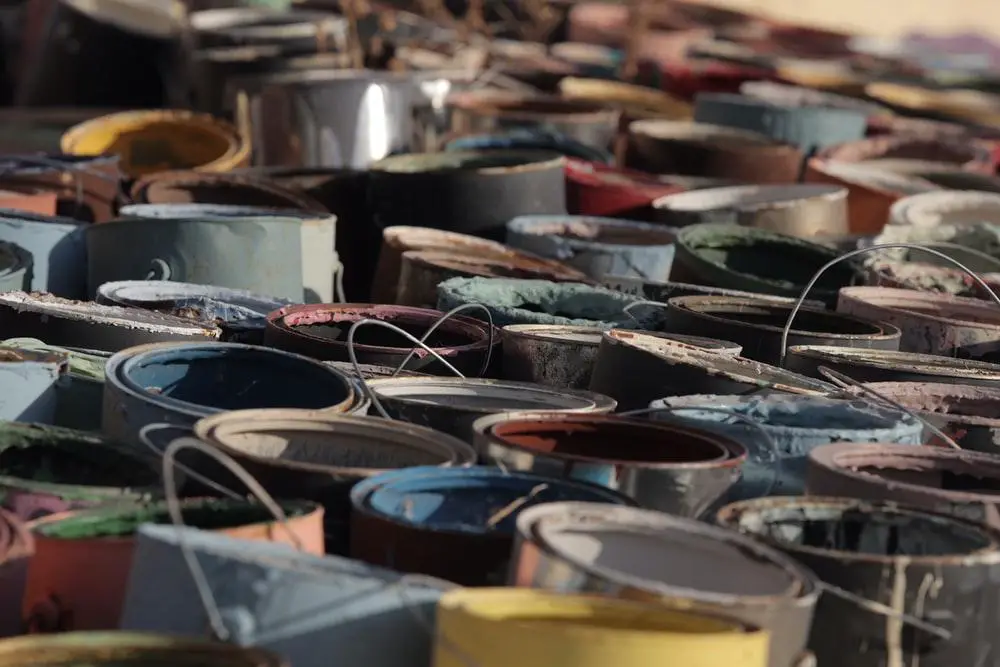
As already mentioned, it will certainly cost more to get the job done by a professional. But even when you’re doing your own paint job, the money in your pockets will slowly disappear.
Just the pigment layer can cost you $10 per gram. And since you’ll need close to about 100 grams for your car, you can end up spending $1,000 for the pigment alone. And that’s only the pigment of one color layer.
The other layers can cost well over $650 each for the entire car. Add in the dielectric layer and the clear coating, and you can end up spending about $2,300 over a simple paramagnetic paint job.
If you want to get it done by a professional such as LitCoat, labor costs will also come into play. So expect the price to shoot up to $2,500 to $5,000 if you really want a good paint job.
Back To The Original Question…

So what about that color-changing Lamborghini? Is it real? While such technologies do exist, unfortunately, this one particular case was faked.
The viral video was a conceptual CGI project made by Instagram artist Iskander Utebayev. It was a concept design that would help engineers and visual experts get a gist of the idea. But it hasn’t been implemented yet.
There can be a few reasons why such technology cannot be implemented. Firstly, pragmatic paints cost a lot, and painting them all over the Lambo would be highly unfeasible.
Secondly, the video shows sudden changes in the colors of various patterns. Most electroluminescent paints don’t have sudden color shifts. And can only shift between a few colors of your choice. The more colors you want to add, the more the cost will be.
And finally, the patterns and art displayed on the car are too complex to implement using paramagnetic paints. Only a few simple shapes and symbols are plausible. But entire digital wallpapers are out of the question.
Final Thoughts:
Even though the viral Lamborghini video was a farce, it is still mind-blowing to know that similar paint already exists. Color-changing paints exist in two forms: chameleon paints and paramagnetic paints.
While both of these paints don’t come close to what we saw in the video, they might come in the future. Recent developments are turning in favor of such breakthroughs. And that day isn’t far when the color-changing Lamborghini becomes a reality.
If you’re planning on getting color changing paint for yourself, it is important to consider the price. You won’t get it for cheap. But the result will always be astonishing.



Which company will paint my car in this –IF I allow them to put THEIR advertisement on it?
car 🏎🚗🚙
Wow, I so want a color changing car.
Car painting and related thing that you have shared is really amazing. Thanks for the information. Subscribed your blog.